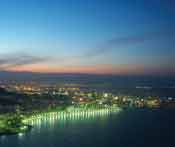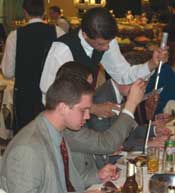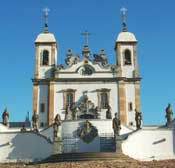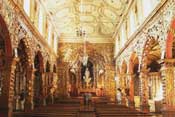
Breathtaking view of Rio taken from the cable car going up Sugar Loaf Mountain.
I just returned from Brazil with five other American students. The 20-day program, A Trip to Brazil, the Birthplace of the First TFP, sponsored by The American Society for the Defense of Tradition, Family and Property — TFP, was incredible! The trip lasted from August 13 until September 3, 2003, and was an excellent mixture of informative lectures and sightseeing. It was also truly remarkable to see a country with a rich Catholic history.
Our first stop was the beautiful city of Rio de Janeiro. Here, we stayed at Hotel Novo Mundo. After recovering from our exhaustive flight, we went up Sugar Loaf Mountain, where we witnessed fantastic views of the city.

That evening, we all got a real taste of typical Brazilian cuisine at a “Churrascaria,” which is an all-you-can-eat barbecue. The next day, we rose early and went to Corcovado Mountain, where the massive statue of Christ the Redeemer overlooks the city. Then we set off on a ferry ride around the bay of Rio de Janeiro. The bay is surrounded by 7 forts that protected it. We spent the evening touring a Benedictine monastery, where a friendly monk gave us an extended tour.
Early the following day, we left for Belo Horizonte, stopping in the small city of Petropolis on the way to visit the 19th century Imperial summer palace of Emperor Pedro II, Brazil’s last monarch. For a moment, we thought we were in Europe, not Brazil.

At Belo Horizonte, the capital of the state of Minas Gerais, we stayed at a house owned by the TFP and the next day went to the Church of the Bom Jesus, a stunning church surrounded by stone-carved statues of the prophets by the artist Aleijadinho, a famous sculptor from the 18th century who was born and lived in Minas Gerais. His work is famous not only because of its beauty but also because Aleijadinho did not have hands. To carve the statues he had others attach his tools to his short arms.
In the colonial village of Sabara we discovered a unique aspect of Brazilians their goodness. For example, two young black boys, on their way back home from school, stopped on the side-walk to play their violas for us.
Another point of interest was the Serra da Piedade Mountain of the Pieta and its marvelous Portuguese-style church. From here we had a fantastic view of Brazilian landscape. Yet, unfortunately, on the other side of the mountain, we discovered a very ugly church. Someone in our group remarked that it looked more like a stealth bomber than a church.
Regionalism, Tradition and Good Taste
Our final destination was the huge city of Sao Paulo, birthplace of the first TFP. There, we saw many places associated with the TFP and the life of its founder, Prof. Plinio Corrêa de Olivera. Visiting the headquarters of the Brazilian TFP, known as the Reign of Mary Center, was a highlight. Originally built in the late 1800s, it was one among many magnificent traditional houses in an elite residential neighborhood of the city. Unfortunately, due to rapid and prolific modern demolition and construction, the house is one of the few of its kind still standing. The décor and ambience within this building are strikingly uplifting, in stark contrast to the concrete jungle of skyscrapers nearby.
 Learn All About the Prophecies of Our Lady of Good Success About Our Times
Learn All About the Prophecies of Our Lady of Good Success About Our Times
TFP founder, Prof. Plinio Corrêa de Oliveira, found enormous consolation in the prophecy of Our Lady of Fatima, that Her Immaculate Heart would triumph. Saint Louis de Montfort talks about a Reign of Mary that would come before the end of time, in which the Catholic Faith and devotion to Mary would spread throughout the whole world. The “philosophy of the gospels” that imbued the Middle Ages, as Pope Leo XIII very aptly described, would again permeate society. Plinio Corrêa de Oliveira wanted a center that would reflect the spirit of this era as best as possible. And to honor these prophecies, this headquarters is called the Reign of Mary Center.

On approaching this magnificent two-story building, one cannot help but notice the enormous grand standard of the TFP on the street corner with the inscription, “Tradition, Family, Property,” overlooking and dominating the intersection. Entering the seat, you will find rooms decorated with fine original portraits, vases, and furniture, and elaborate woodwork. This center not only gives a glimpse of Christian civilization, but also helps to show the true Brazil, unknown to many Americans.
During the stay in Sao Paulo, we attended numerous interesting lectures given by members of the TFP. One meeting, for example, was given by Prince Bertrand of Orleans-Braganza, about the importance of chastity in our lives.
The trip to Brazil was an opportunity to see many Catholic aspects of the country and its people and to learn about the history of the TFP. It was definitely an unforgettable experience.

